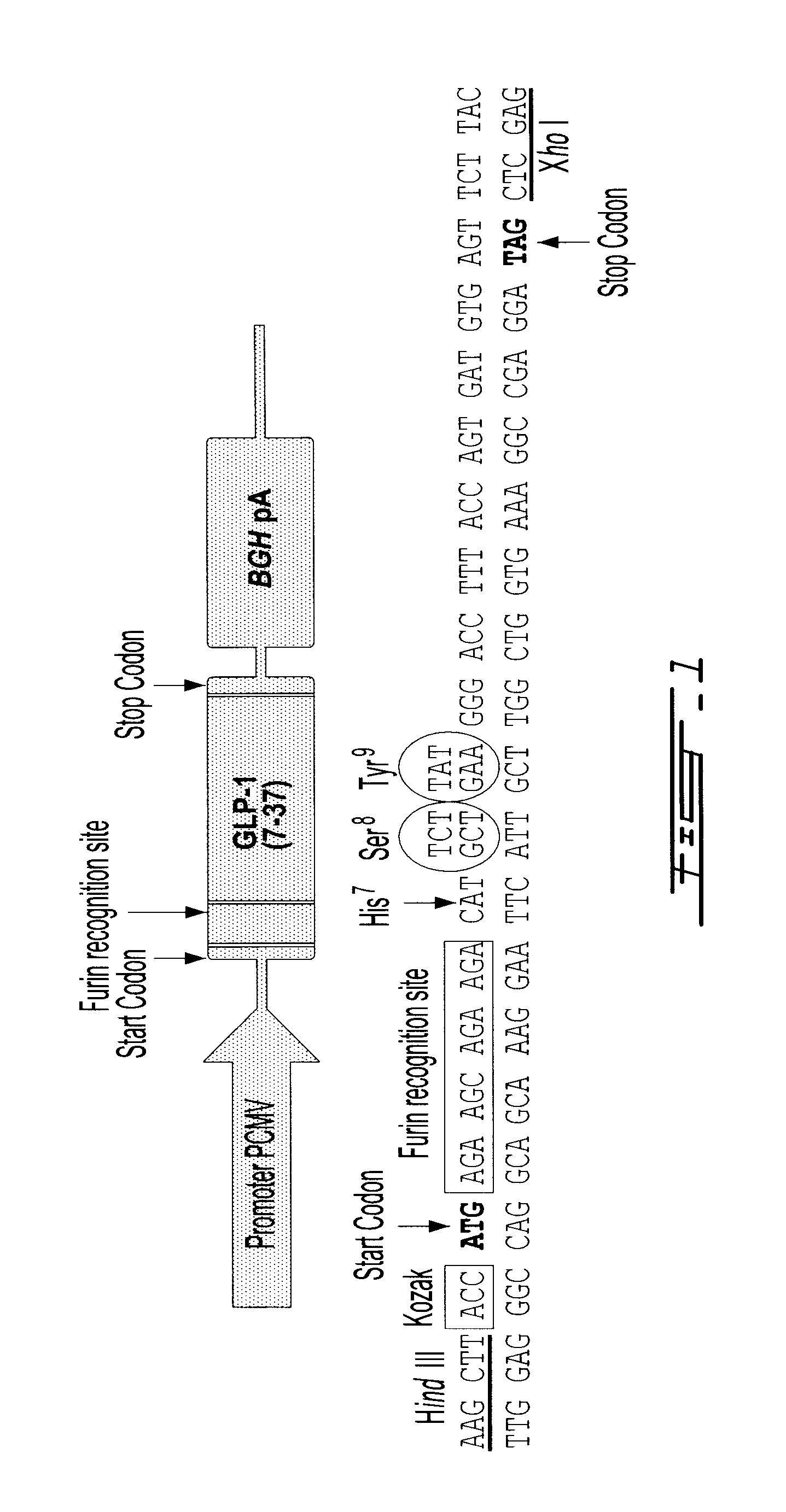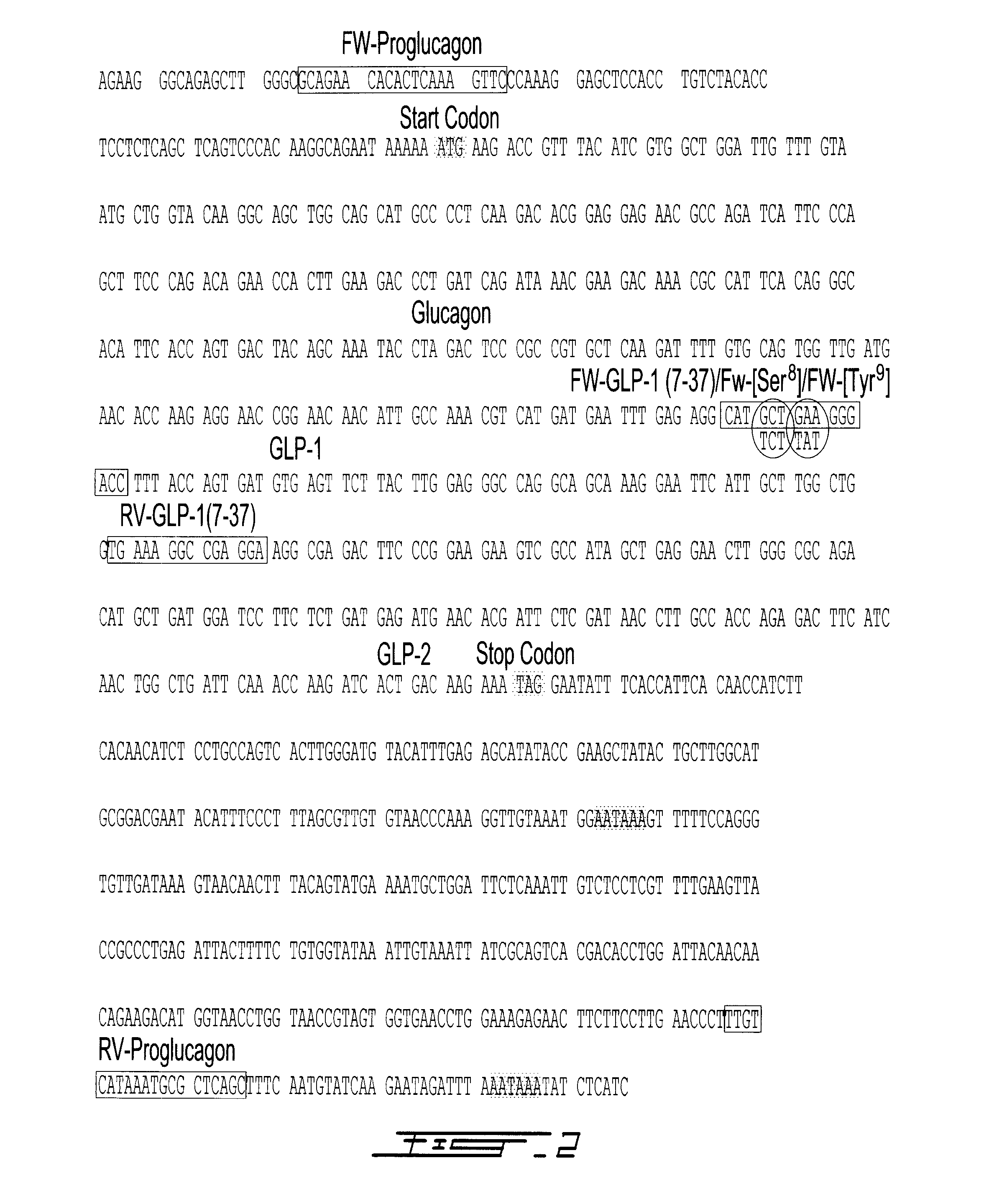Gene therapy for diabetes with chitosan-delivered plasmid encoding glucagon-like peptide 1
a glucagon-like peptide, chitosan-delivered technology, applied in the direction of peptide/protein ingredients, drug compositions, metabolic disorders, etc., can solve the problems of less than 10% of the administration of glp, short half life of glp-1, and change in the gene expression of skeletal muscle, so as to reduce the circulating half life of incretin, reduce the weight gain of patients, and reduce blood glucose levels
- Summary
- Abstract
- Description
- Claims
- Application Information
AI Technical Summary
Benefits of technology
Problems solved by technology
Method used
Image
Examples
example i
Preparation of Chitosan
[0100]Ultrapure chitosan samples were used where quality controlled manufacturing processes eliminate contaminants including proteins, bacterial endotoxins, toxic metals, inorganic and organic impurities. All chitosans had less than 50 EU / g of bacterial endotoxins. These chitosans were produced by heterogenous deacetylation resulting in a block rather than random distribution of acetyl groups Chitosans were selected having a 92% and 80% of degree of deacetylation and molecular weight of approximately 10 kDa and 80 kDa were produced by chemical degradation using nitrous acid as described previously (Layertu 2006).
[0101]Depolymerized chitosans were dissolved overnight on a rotary mixer at 0.5% (w / v) in hydrochloric acid using a glucosamine:HCL ratio of 1:1. Chitosan solutions were then diluted with deionized water to reach the desired amine to phosphate ratio when 100 μl of chitosan would be mixed with 100 μl of pVax-GLP-1, the latter at a concentration of 0.33 ...
example ii
Cell Line Dependencies Testing
[0102]At least two cell types in each category (DPP-IV expressing cells and DPP-IV non-expressing cells) were tested to assess cell line dependencies. HepG2, Caco2, HT-29, HEK293 and HeLa cells were cultured in MEM medium supplemented with 10% FBS. HeLa and HT29 were cultured in McCoy's and DMEM media, respectively, supplemented with 10% FBS at 37° C. and 5% CO2. HepG2, Caco-2 and HT-29 cell line expresses dipeptidyl peptidase IV (DPP IV) and represent model cell lines in diabetes research. Cells were subcultured according to ATCC recommendations without any antibiotics. For transfection, HT-29, HepG2, HEK293, HeLa and Caco-2 cells were plated in 24-well culture plates using 500 μl / well of complete medium and 300,000 cells / well, incubated at 37° C. and 5% CO2. The cells were transfected the next day at 50% confluency.
[0103]Complete transfection media were equilibrated overnight at 37° C. and 5% CO2 and pH adjustment was performed with sterile HCl (1N) j...
example iii
[0104]The ability of the nanoparticles to protect plasmid DNA (pDNA) sequences was assessed using a DNAse protection assay. Nanoparticles of chitosan / pDNA (6 μl) were incubated in a buffer containing (pH 6.5) 20 mM MES, 1 mM MgCl2 and a concentration of 0, 0.5, 1, 2, 5 or 10 units of DNase I. samples are incubated for 30 minutes at 37° C. The reaction was stopped by adding 2 μl of EDTA (50 mM). To ensure proper migration of the remaining pDNAs, samples were treated with Streptomyces griseus type III chitosanase at 10 mU / μL for 1.5 hours at 37° C. Samples were migrated at 90 V during 1 hour then stained with ethidium bromide (0.5 μg / mL) before visualization. The results demonstrate the ability of the formulations to protect plasmid DNA (FIG. 4). The protection is considerable and account for approximately 70% of pVac-GLP-1 when using 2 units of DNAse I / μg of DNA whereas the negative control is completely digested when 0.5 units of DNAse I per μg of DNA is used. ...
PUM
| Property | Measurement | Unit |
|---|---|---|
| Fraction | aaaaa | aaaaa |
| Fraction | aaaaa | aaaaa |
| Fraction | aaaaa | aaaaa |
Abstract
Description
Claims
Application Information
 Login to View More
Login to View More - R&D
- Intellectual Property
- Life Sciences
- Materials
- Tech Scout
- Unparalleled Data Quality
- Higher Quality Content
- 60% Fewer Hallucinations
Browse by: Latest US Patents, China's latest patents, Technical Efficacy Thesaurus, Application Domain, Technology Topic, Popular Technical Reports.
© 2025 PatSnap. All rights reserved.Legal|Privacy policy|Modern Slavery Act Transparency Statement|Sitemap|About US| Contact US: help@patsnap.com



